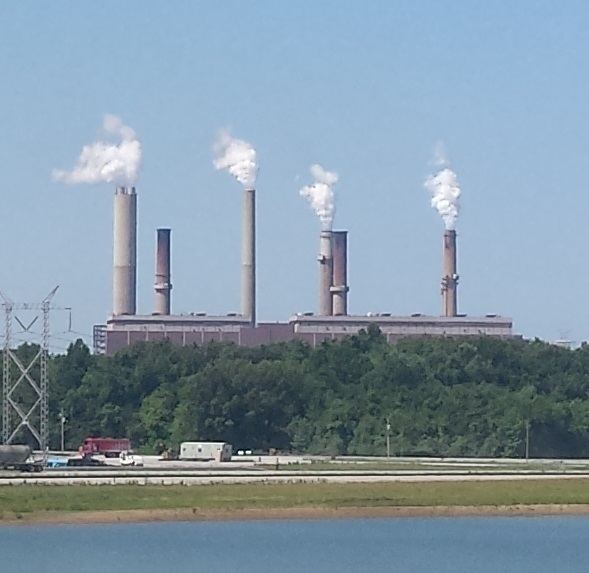Decommission date none | Status Active Phone +1 812-386-8491 | |
 | ||
Commission date 1971–82 under Public Service Indiana Address 1097 N 950 W, Owensville, IN 47665, USA Hours Closing soon · 7AM–3:30PMMonday7AM–3:30PMTuesday7AM–3:30PMWednesday7AM–3:30PMThursday7AM–3:30PMFriday7AM–3:30PMSaturdayClosedSundayClosed Similar Cayuga Generating Station, Petersburg Generating Station, Merom Generating Station, F B Culley Generating Station, Edwardsport Power Station | ||
The Gibson Generating Station is a coal-burning power plant located at the northernmost end of Montgomery Township, Gibson County, Indiana, United States. It is close to the Wabash River, 1.5 miles southeast of Mount Carmel, Illinois, 2 miles south of the mouth of the Patoka River, and 4 miles south of the mouth of the White River. The closest Indiana communities are Owensville 7.5 miles to the southeast of the plant, and Princeton, 10.5 miles to the east. With a 2013 aggregate output capacity among its five units of 3,345 megawatts, it is the largest power plant run by Duke Energy, the third-largest coal power plant in the world, and the tenth-largest electrical plant in the United States, With the reduction of Nanticoke Generating Station, it became the largest coal power plant in North America by generated power late in 2012. Also on the grounds of the facility is a 3,000-acre (12 km2) large man-made lake called Gibson Lake which is used as a cooling pond for the plant. Neighboring the plant is a Duke-owned, publicly accessible access point to the Wabash River near a small island that acts as a wildlife preserve. This is the nearest boat-ramp to Mount Carmel on the Indiana side of the river. Located immediately south of Gibson Lake, the plant's cooling pond, is the Cane Ridge National Wildlife Refuge, the newest unit of the Patoka River National Wildlife Refuge and Management Area. Opened in August 2006, this 26-acre (11 ha) area serves as a nesting ground for the least tern, a rare bird. Cane Ridge NWR is reportedly the easternmost nesting ground for the bird in the U.S. The Gibson Generating Station is connected to the power grid via five 345 kV and one 138 kV transmission lines to 79 Indiana counties including the Indianapolis area and a sixth 345 kV line running from GGS to Evansville and Henderson, owned by Vectren and Kenergy.
Contents
History
Gibson Generating Station was originally built as a two-unit coal-fired power plant in 1972 by Public Service Indiana (PSI) with initial plans to build 8 units. The 1970s saw the addition of Units 3, 4, and 5 in 1982, but only two more stacks. In the 1990s, number 4 was separated from number 3's stack and each was given its own stack.
Cinergy took over PSI in 1995. During this time, all five units were fitted with new Selective catalytic reduction (SCR) units, mounted on the back of each unit. During this construction, one of the largest cranes in the world was erected at GGS. Despite this the station only had 4 stacks for 5 units. Units 1 & 2 still shared a single-flued smokestack and Unit 3 was still using the old 3 & 4 smokestack (the two darker smokestacks in the above photograph).
Duke Energy took over Cinergy in May, 2006.
Recent additions
Work was just recently completed on the plant's two new 620 ft (190 m) smokestacks. The wider two-flue stack is for Units 1 & 2 with a flue for each unit, replacing the older, share-flued smokestack, while the narrower stack is for Unit 3, completely replacing the old 3 & 4 smokestack. All four newer smokestacks (1 & 2, 3, 4, & the older Unit 5) all usually put out a full plume while the older two are now stripped out derelicts pretty much left to nesting cliff birds such as the Peregrine falcon or the Bald eagle which are among the usual residents around the Main Plant Complex.
A series of SCR units have been installed to decrease its NOx emissions, these improvements were completed in 2008 with Unit 5 being the last. Several projects are being planned to increase the capacity of the station to as much as 3,750 MW.
Earthquake effects
At 4:37:00am CDT (9:37:00 UTC) on April 18, 2008, a 5.4 Mw earthquake rocked the area with a maximum Mercalli intensity of VII (Very strong). The epicenter was located 7 miles (11 km) northwest of the station in nearby Wabash County, Illinois. Some minor damage was recorded but the only visible effect was that Unit 4 deactivated itself because of its vibration detectors.
